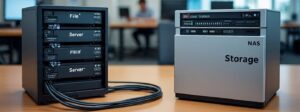
Advanced Robotics in 2025: How Smart Machines Are Changing Our World
Introduction: Robots Are No Longer Science Fiction
Remember when robots only existed in movies? By 2025, they’ll be cooking our meals, performing surgery, and even exploring other planets. But don’t worry—they’re here to help, not take over (yet)!
This easy-to-understand guide covers:



What Are Advanced Robots? (Simple Explanation)
Advanced Robots: Smart Machines That See, Think, and Act
Advanced robots are intelligent machines that can do much more than follow simple, pre-programmed commands. They can:
-
Sense Their Environment – Using cameras, microphones, and sensors, robots can detect objects, recognize voices, measure distances, and even feel textures.
-
Example: Self-driving cars use cameras and radar to “see” other vehicles, pedestrians, and traffic signs.
-
Example: A robot vacuum like a Roomba uses sensors to avoid stairs and navigate around furniture.
-
-
Think and Make Decisions – Thanks to artificial intelligence (AI), robots can analyze data, learn from experience, and adapt to new situations.
-
Example: AI-powered robots in warehouses decide the fastest way to pick and pack orders.
-
Example: Medical robots assist surgeons by analyzing real-time data during operations.
-
-
Act Independently – Unlike traditional machines that need constant human control, advanced robots can work on their own.
-
Example: Drones can deliver packages by calculating the best route without a pilot.
-
Example: Factory robots assemble cars with precision, adjusting their movements as needed.
-
Everyday Examples You Might Already Use:
Advanced robots are no longer just sci-fi—they’re already in our homes, cars, and pockets! Here are three real-world examples of how these smart machines are changing daily life:
1. Roomba: The Robot Vacuum That “Learns” Your Home
-
What it does: Unlike old vacuums that bump around randomly, Roombas use sensors and cameras to map your home, remembering where furniture, walls, and obstacles are.
-
Why it’s smart: Over time, it plans the most efficient cleaning path, avoids falls (like stairs), and can even empty its own dustbin!
-
Fun fact: Some models work with Alexa, so you can say, “Alexa, tell Roomba to clean the kitchen!”
2. Tesla’s Self-Driving Cars: A Robot on Wheels
-
What it does: Tesla cars use cameras, radar, and AI to steer, brake, and change lanes—almost like a human driver (but with faster reflexes!).
-
Why it’s smart: The car learns from millions of miles driven by other Teslas, improving its decisions over time (like recognizing stop signs or avoiding sudden obstacles).
-
Example: If traffic ahead slows down, the car adjusts speed automatically—no driver needed!
3. Alexa: A Robot Without a Body
-
What it does: Alexa (or Google Assistant/Siri) is like a voice-controlled robot brain. It can’t move, but it listens, thinks, and responds using AI.
-
Why it’s smart: It learns your habits—like playing your morning playlist, adjusting smart lights, or even ordering groceries when you ask.
-
Example: Say, “Alexa, remind me to water the plants every Saturday,” and it’ll remember forever (unlike humans!).
5 Game-Changing Robot Types Coming in 2025
1. Medical Robots: Your Surgeon’s New Assistant
What They Do:
-
Perform ultra-precise surgeries
-
Never get tired or shaky hands
Real Examples:
-
Da Vinci Surgical System (used in 1M+ surgeries/year)
-
2025 Development: Micro-robots that swim in your bloodstream to deliver medicine
2. Home Helper Robots
Coming Soon:
-
Robots that fold laundry (finally!)
-
Elderly care assistants that help with mobility
Current Tech:
-
Samsung Bot Handy (picks up toys and loads dishes)
3. Manufacturing Robots 2.0
New Abilities:
-
Work safely alongside humans
-
Learn new tasks overnight
Cool Example:
-
BMW’s factories where robots and humans build cars together
4. Agricultural Robots
Solving:
-
Farmer shortages
-
Food waste
Amazing Robots:
-
Tortuga AgTech’s fruit-picking robots
-
2025 Prediction: Robot bees that pollinate crops
5. Disaster Response Robots
Life-Saving Work:
-
Search collapsed buildings
-
Put out forest fires
Real Heroes:
-
Boston Dynamics’ Spot robot inspecting dangerous areas
How These Robots Actually Work (Simplified)
Robots seem magical, but they actually rely on four key parts working together – just like humans! Here’s the breakdown in simple terms:
 “Eyes & Ears” – Sensors
“Eyes & Ears” – Sensors
Robots use special tools to sense the world:
-
Cameras (like smartphone cameras) to see objects and faces
-
Lasers/LiDAR (like Tesla’s self-driving cars) to measure distances
-
Microphones (like Alexa) to hear voice commands
Example: A Roomba uses infrared sensors to avoid pet toys while cleaning.
 “Brain” – AI Software
“Brain” – AI Software
This is where the magic happens! Robots:
-
Learn from experience (e.g., Tesla cars improve driving after every trip)
-
Make decisions (e.g., Factory robots choose which part to pick next)
-
Recognize patterns (e.g., Alexa learns your daily routine)
Cool fact: ChatGPT’s cousin AI helps robots understand human language!
 “Body” – Movement Systems
“Body” – Movement Systems
Robots move using:
-
Motors (like tiny car engines) for wheels/arms
-
Grippers (some even have soft “fingers” to hold eggs safely!)
-
Hydraulics (big robots like car-assemblers use fluid power)
Surprise! Some robot hands now grip better than humans – no more dropping your coffee!
 “Communication” – Cloud Connection
“Communication” – Cloud Connection
Just like your phone gets updates:
-
Robots download new skills (e.g., your Roomba learns new floor plans)
-
Share data with other robots (e.g., Teslas share road condition alerts)
-
Get emergency fixes (like a software “vaccine” against hackers)
Fun Bonus Facts:



Why This Matters to You
Better Healthcare:
-
Surgeries with smaller scars
-
24/7 home care for grandparents
Improved Products:
-
Cheaper electronics (made by precise robots)
-
Fresher food (harvested at perfect time)
New Jobs:
-
Robot trainers
-
AI ethicists
-
Maintenance technicians
Addressing Common Concerns
“Will robots take all jobs?”
-
Truth: They’ll change jobs more than eliminate them
-
Example: ATMs didn’t end bank tellers—it changed their role
“Are robots safe?”
-
2025 Standards: Force sensors and emergency stops
-
Current Safety: Industrial robots have 99.99% accuracy
The Exciting Future Beyond 2025
-
Self-Repairing Robots: Fix their own wear and tear
-
Emotional Robots: That understand human feelings
-
Space Robots: Building bases on Mars
How to Prepare for the Robot Revolution
-
For Workers: Learn to work with robots (they’re tools, not replacements)
-
For Businesses: Start with simple automation
-
For Everyone: Stay curious about new tech
Final Thought: Partners, Not Replacements
By 2025, advanced robots won’t be our competitors—they’ll be our teammates, doing jobs that are dangerous, dirty, or just dull.




